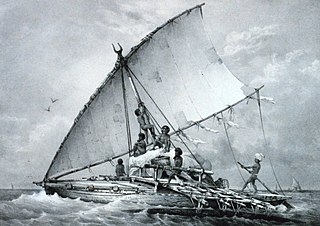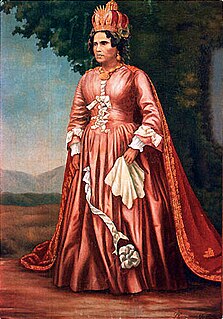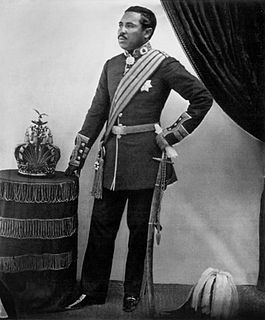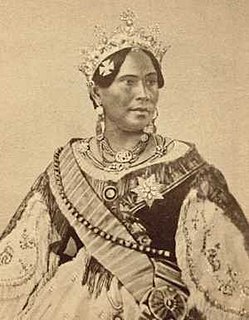
The history of Madagascar is distinguished clearly by the early isolation of the landmass from the ancient supercontinent containing Africa and India, and by the island's late colonization by human settlers from the Sunda islands and from East Africa. These two factors facilitated the evolution and survival of thousands of endemic plant and animal species, some of which have gone extinct or are currently threatened with extinction due to the government not allocating resources to help the growing population, causing many people to resort to harmful environmental practices as a way of survival. Trade in the Indian Ocean at the time of first colonization of Madagascar was dominated by large ships, called Djong, coming from Java and Sumatra.

Antananarivo, also known by its colonial shorthand form Tana, is the capital and largest city of Madagascar. The administrative area of the city, known as Antananarivo-Renivohitra, is the capital of Analamanga region. The city sits at 1,280 m (4,199 ft) above sea level in the center of the island, the highest national capital by elevation among the island countries. It has been the country's largest population center since at least the 18th century. The presidency, National Assembly, Senate and Supreme Court are located there, as are 21 diplomatic missions and the headquarters of many national and international businesses and NGOs. It has more universities, nightclubs, art venues, and medical services than any city on the island. Several national and local sports teams, including the championship-winning national rugby team, the Makis are based here.

Radama I "the Great" (1793–1828) was the first Malagasy sovereign to be recognized as King of Madagascar (1810–1828) by a European state. He came to power at the age of 18 following the death of his father, King Andrianampoinimerina. Under Radama's rule and at his invitation, the first Europeans entered his central highland Kingdom of Imerina and its capital at Antananarivo. Radama encouraged these London Missionary Society envoys to establish schools to teach tradecraft and literacy to nobles and potential military and civil service recruits; they also introduced Christianity and taught literacy using the translated Bible. A wide range of political and social reforms were enacted under his rule, including an end to the international slave trade, which had historically been a key source of wealth and armaments for the Merina monarchy. Through aggressive military campaigns he successfully united two-thirds of the island under his rule. Abuse of alcohol weakened his health and he died prematurely at age 35. He was succeeded by his highest-ranking wife, Ranavalona I.

Ranavalona I, also known as Ranavalo-Manjaka I, was sovereign of the Kingdom of Madagascar from 1828 to 1861. After positioning herself as queen following the death of her young husband, Radama I, Ranavalona pursued a policy of isolationism and self-sufficiency, reducing economic and political ties with European powers, repelling a French attack on the coastal town of Foulpointe, and taking vigorous measures to eradicate the small but growing Malagasy Christian movement initiated under Radama I by members of the London Missionary Society. She made heavy use of the traditional practice of fanompoana to complete public works projects and develop a standing army of between 20,000 and 30,000 Merina soldiers, whom she deployed to pacify outlying regions of the island and further expand the realm. The combination of regular warfare, disease, difficult forced labor and harsh trials by ordeal using a poisonous nut from the Tangena shrub resulted in a high mortality rate among both soldiers and civilians during her 33-year reign, with Madagascar's population reducing from 5 million in 1833 to 2.5 million in 1839.

Radama II was the son and heir of Queen Ranavalona I and ruled from 1861 to 1863 over the Kingdom of Madagascar, which controlled virtually the entire island. Radama's rule, although brief, was a pivotal period in the history of the Kingdom of Madagascar. Under the unyielding and often harsh 33-year rule of his mother, Queen Ranavalona I, Madagascar had successfully preserved its cultural and political independence from European colonial designs. Rejecting the queen's policy of isolationism and persecution of Christians, Radama II permitted religious freedom and re-opened Madagascar to European influence. Under the terms of the Lambert Charter, which Radama secretly contracted in 1855 with French entrepreneur Joseph-François Lambert while Ranavalona still ruled, the French were awarded exclusive rights to the exploitation of large tracts of valuable land and other lucrative resources and projects. This agreement, which was later revoked by Prime Minister Rainilaiarivony, was key to establishing France's claim over Madagascar as a protectorate and, in 1896, as a colony.

Rasoherina was Queen of Madagascar from 1863 to 1868, succeeding her husband Radama II following his presumed assassination.

The Merina people are the largest ethnic group in Madagascar. They are the "highlander" Malagasy ethnic group of the African island and one of the country's eighteen official ethnic groups. Their origins are mixed, predominantly with Austronesians arriving before the 5th century AD, then many centuries later with Arabs, Africans and other ethnic groups. They speak the Merina dialect of the official Malagasy language of Madagascar.

Fort-Dauphin, in Malagasy also used: Tolagnaro or Taolagnaro, is a city on the southeast coast of Madagascar. It is the capital of the Anosy Region and of the Taolagnaro District. It has been a port of local importance since the early 1500s. A new port, the Ehoala Port was build in 2006-2009. Fort-Dauphin was the first French settlement in Madagascar.

The Mangoky River is a 564-kilometer-long (350 mi) river in Madagascar in the regions of Atsimo-Andrefana and Anosy. It is formed by the Mananantanana and the Matsiatra. Another important affluent is the Zomandao River.

Ambohimanga is a hill and traditional fortified royal settlement (rova) in Madagascar, located approximately 24 kilometers (15 mi) northeast of the capital city of Antananarivo. It is situated in the commune of Ambohimanga Rova.
Articles related to Madagascar include:

Ambatondrazaka is a city in Madagascar

The Franco-Hova Wars, also known as the Franco-Malagasy Wars were two French military interventions in Madagascar between 1883 and 1896 that overthrew the ruling monarchy of the Merina Kingdom, and resulted in Madagascar becoming a French colony. The term "Hova" referred to a social class within the Merina class structure.

The Rova of Antananarivo is a royal palace complex (rova) in Madagascar that served as the home of the sovereigns of the Kingdom of Imerina in the 17th and 18th centuries, as well as of the rulers of the Kingdom of Madagascar in the 19th century. Its counterpart is the nearby fortified village of Ambohimanga, which served as the spiritual seat of the kingdom in contrast to the political significance of the Rova in the capital. Located in the central highland city of Antananarivo, the Rova occupies the highest point on Analamanga, formerly the highest of Antananarivo's many hills. Merina king Andrianjaka, who ruled Imerina from around 1610 until 1630, is believed to have captured Analamanga from a Vazimba king around 1610 or 1625 and erected the site's first fortified royal structure. Successive Merina kings continued to rule from the site until the fall of the monarchy in 1896, frequently restoring, modifying or adding royal structures within the compound to suit their needs.

Anosy is one of the 22 regions of Madagascar. It is located in the southeast of the country, on the eastern side of what was once the Toliara Province. The name Anosy means "island(s)" in Malagasy.

The Antanosy is a Malagasy ethnic group who primarily live in the Anosy region of southeastern Madagascar, though there are also Antanosy living near Bezaha, where some of the Antanosy moved after the Merina people conquered Anosy. An estimated 360,000 people identify as Antanosy as of 2013.

The twelve sacred hills of Imerina are hills of historical significance to the Merina people of Madagascar. Located throughout Imerina, the central area of the highlands of Madagascar, the sites were often ancient capitals, the birthplaces of key public figures, or the tomb sites of esteemed political or spiritual leaders. The first set of sacred sites was designated by early 17th-century king Andrianjaka. The notion was re-sanctified under late 18th-century king Andrianampoinimerina, who replaced several of the earlier sites with new ones. More than 12 sites were thus designated as sacred over time, although the notion of twelve sacred hills was perpetuated because of the significance of the number 12 in Malagasy cosmology. Today, little concrete evidence of the former importance of many of these sites remains, but the significant archeological and cultural heritage of several of the sites has been preserved. The historic significance of the sites is best represented by the Rova of Antananarivo at Analamanga, the ancient fortified city at Alasora, the houses and tombs of the andriana at Antsahadinta and the ancient fortifications and palaces at Ambohimanga, protected as a UNESCO World Heritage Site since 2001.
James Cameron (1799–1875) was a 19th-century Scottish artisan missionary with a background in carpentry who, over the course of twenty-three years of service in Madagascar with the London Missionary Society, played a major role in the Christianization and industrialization of that island state, then under the rule of the Merina monarchy.

Christianity in Madagascar is practiced by 85.3% of Madagascar's population according to the Pew Research Center in 2010, often in syncretic form with traditional religious practices. Protestantism was introduced by the first envoys of the London Missionary Society in 1818, who proselytized and taught literacy through a Malagasy language Bible at the public schools they established in the highlands at the request of King Radama I. The number of converts remained low but gradually grew under repression during the reign of his successor, Queen Ranavalona I, and the more permissive religious policies of her son, Radama II, and his widow, Queen Rasoherina.
Saint Michael Higher Technical Institute, Amparibe, was founded by the Jesuits in 1983 in Antananarivo, Madagascar.



















